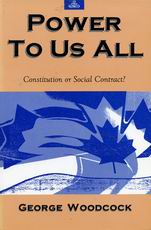
Power To Us All
Constitution or Social Contract?
Woodcock, George
Publisher: Harbour Books
Year Published: 1992
Pages: 191pp ISBN: 1-55017-073-2
Library of Congress Number: JL31.W65 1992 Dewey: 320.471
Resource Type: Book
Cx Number: CX6501
Woodcock calls for a true participatory democracy.
Abstract:
In Power to Us All, Woodcock argues that Canadians' alienation from the political decision-making process and the debates over the constitution is due to Canada's natural diversity and the history of local culture and tradition that unifies the country. Providing a case for "creative anti-national disunity," Woodcock argues that the true political way for Canada is "a true participatory democracy." When there is a constitution there is a tendency for the executive government to make most of the decisions. Since confederation, Canadian politics was dominated by the debate over the division of power in the BNA between provincial politicians and Ottawa's cabinets. However, the original aim of confederation was to unify the historical, geographical and cultural diversities, not to collaborate over legislative decisions. Thus, a unity of the diverse, which prioritize local loyalties over national loyalty, is needed as achieved by the Swiss. This means recognizing the individual in the form of a third local level of decision making and administrative processes.
His collection of eight essays follow a "figuratively confederatist format" as each essay hold an autonomous discussion about the future of Canada. Yet the essays also cross-reference each other and follow a natural sequence to work up to the solution Woodcock proposes. The first two essays debunk two myths of Canadian politics: the first one being the enshrinement of the adversarial system in parliamentary, judicial and industrial relations, which create further tensions in politics than solving them. Furthermore, Woodcock argues that our fixation with good leadership and a party system reliant on leaders is a barrier to establishing a just system based on popular participation. The third essay proposes how native self-government structures suggest that we end the "wardship" of these nations and encourage tribes to establish autonomous institutions. Similarly, the fourth essay encourages the recognition of regional societies that are "geohistorically" and culturally distinct, while the next piece looks at the importance of recognizing distinct smaller societies and communities within an area, such as the Sikhs in Vancouver. The seventh essay examines the importance of transport and communication systems in a large country like Canada. The next essay covers how the external and internal politics of a country are connected and establishes that our independence can not be seen as a disadvantage to our neighbors. Finally, the concluding chapter summarizes the way and means: "a complex three level administrative structure that ensures maximum participation from the bottom." This arrangement, which will highlight and give credit to our pluralism, can be Canada's contribution to idea of national sovereignty.
[Abstract by Amanpreet Dhami]
Table of Contents
Permutations of Power: An Introductory Essay
1. Ding Dong! Or, Knights in Rusty Armour
2. Fools and Führers: Leadership and Five-Year Fancies
3. Firstcomers and Latecomers
4. Mending a Fragmented Fatherland
5. A Forest Survives Through its Undergrowth
6. Roads of Iron, Waves of Power
7. Canada in the Ecology of Global Society
8. Ways and Means: The Necessary Disobedience
Subject Headings


